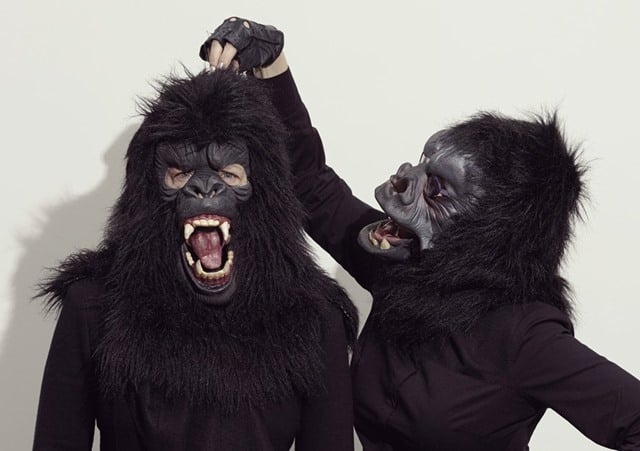People
The Guerrilla Girls Call Out Art World Moneymakers on Stephen Colbert’s Show
Why focus on art, Colbert asks?

Photo: via the Walker Art Center, Minneapolis.
Why focus on art, Colbert asks?

Brian Boucher

Three of the anonymous activist artists known as the Guerrilla Girls brought their incisive criticism of art-world sexism and exclusivity to “The Late Show with Stephen Colbert” last night ahead of taking over the Twin Cities later this month.
Colbert doesn’t always have artists on his show, but when he does, it tends to be good, as when he hosted Jeff Koons on the “Colbert Report.”
On the show, Frida Kahlo lays out the Girls’ thirty-year history of calling attention to art-world sexism, and while Colbert mostly isn’t playing dumb the way he did for his right-wing blowhard persona on the “Colbert Report,” he does when he inquires, “Does art speak for itself or does it have to be gender-identified?”
Every aesthetic decision, Frida points out, reflects a value system, and if the values are determined by wealthy men, then art museums are not truly representative.
“Unless all the voices of our culture are in the history of art, it’s not really a history of art—it’s a history of power,” she says to applause.

The Guerrilla Girls took to Late Night with Stephen Colbert last night.
Why did you choose gorillas, Colbert asks, imagining that it must be getting stuffy in there after three decades. “Is it dehumanizing,” he wonders, “or because they’re scary?”
Kahlo explains that the name, with its excellent double entendre, resulted from a spelling error by one of the group’s early members. While they were already wearing the masks, it was when she wrote guerrilla for gorilla that inspiration struck, in what must be one of art history’s greatest instances of serendipitous misspelling.
When Colbert asks whether a Girl has ever been unmasked, Käthe Kollwitz says, “That’s a really good question.”
People try to guess, Kollwitz concedes, but points out that they’re almost always wrong. (She’s wearing green-framed glasses, so if you are looking for a scoop, be on the lookout for telltale eyewear.)
It’s often said, Colbert observes, that history is just a record of violence. Does that apply to the art world, he asks? “It’s my metaphor, but explain it to me,” he deadpans. The Girls, of course, say yes.
Colbert then cites depressing statistics about the gender breakdown of artists honored with major New York museum retrospectives thirty years ago and now, to point out that little has changed. The Girls rightly point out that this just demonstrates the ongoing need for their commentary.
Critics of art-world activism often whine that the art world is too small a sphere to care about, and Colbert (rhetorically I hope) poses that basic question, pointing out that Congress, the tech world, and even “the matador world” are all male-dominated, along with late-night TV.
So why choose art, he wonders?
Kollwitz takes credit for the Girls’ status as early culture jammers, using humor to present facts in a way that might change minds in a way that has spread so widely that even Colbert’s previous show arguably owes a debt to the Girls’ brand of skeptical satire.
Colbert then questions the Girls on museum funding. Institutions are supported by billionaire donors. Do they call the shots, he asks?
Yes, say the Girls. Morevoer, Kollwitz opines that it’s not just the billionaire art collectors—it’s the billionaire art dealers. (On a quick scan of the top three hundred, we don’t see any billionaire art dealers on Forbes’ list, but hey, Käthe, if you know better, we believe you.) They control the art world, she says, and they buy the art for the museums, they’re much more likely to give art for money that they already have, and they’ve all got cookie-cutter collections, she says.
Why, she says, can’t we support all the other great artists out there?